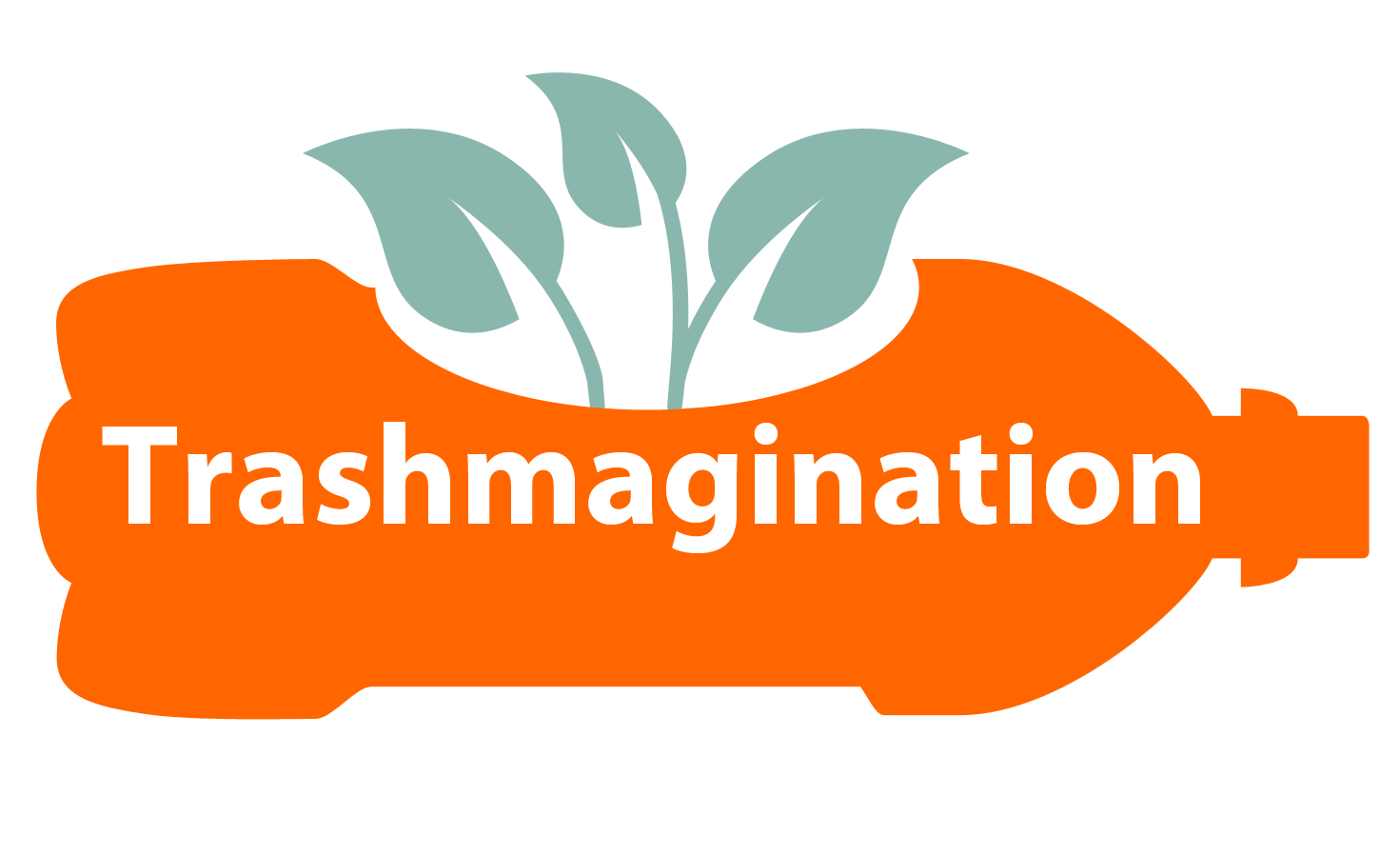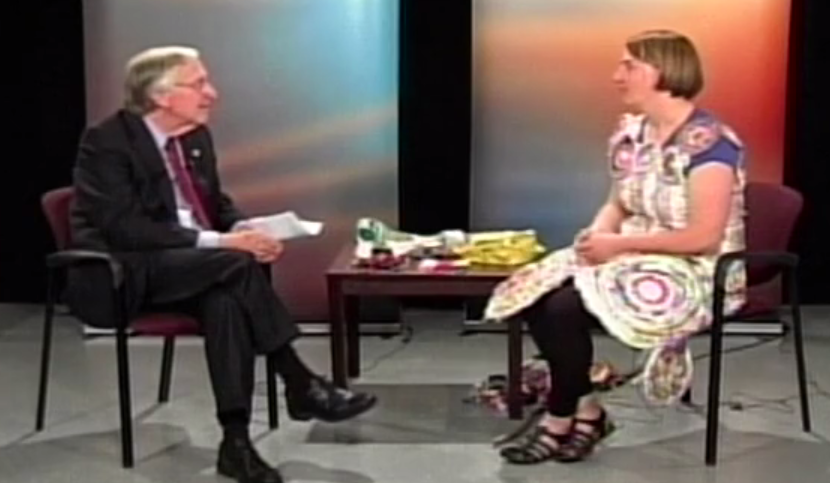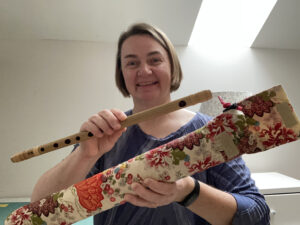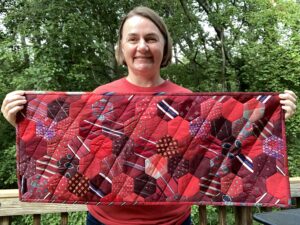Thank you to my state delegate Ken Plum for interviewing me about Trashmagination for his local TV show, Virginia Report. The interview used to be available on Vimeo but has now been removed. It was fun! Here’s a transcript of the interview:
Delegate Plum: Hi, I’m Delegate Ken Plum. Welcome to our show Virginia Report. Now what do you do with your trash around the home? If you simply throw it out, you may be losing an opportunity. Tonight we are going to talk about Trashmagination. I’m happy to welcome to the show Carla Brown. Carla you and I met at Maker Faire a couple of years ago, and I saw some of the very creative things you were doing with trash. How did you get the notion or how did you get started with this idea of using trash to make things?
Carla: When I was a teenager, I was going to college in British Columbia and we had a week where we would do volunteering. We volunteered at an island called Hornby Island which is a garbage-free island. And you say, how is that even possible? They had so many systems in place. For example, there were a lot of potters on the island who would make pottery and people would bring them to the grocery store. So things like liquids like honey and that kind of thing, they wouldn’t even get packaging, they would just have their pots. I worked at a place that was a Free Store. Now we have this concept of Freecycle, where everybody gives away their stuff to each other. Back then it was kind of a new idea. So people would bring their stuff to this store, and other people would just take it for free. I worked there for a week and I loved it. I just thought this is so sensible and at the time I was also studying art, so from then on, I just used trash as my main medium when I was making my art.
Delegate Plum: Maybe we should change our language and not say that this is trash. We could say it is a natural resource or something like that.
Carla: It’s true. To me, garbage day is a hard day actually. When I walk up the street, my husband says “You’ve got to leave it there” because I see potential. I see so many things getting tossed that I would just love to remake the furniture or take the things that just need a little bit of cleaning up.
Delegate Plum: We need – since viewers are wondering about your dress – it is different. Tell us about it.
Carla: There is an event happening on May 21st, a Trashion Fashion show. Designers from all over the Washington DC area are designing clothes to wear in this fashion show. I heard about it a year ago, and I said, I just absolutely have to design something for that. So I made this dress. The rules of the fashion show is that you can’t use fabric. So that’s the tricky part when you are trying to make clothing. I decided to go with all plastic bags. This dress is entirely woven from plastic bags. I hadn’t done a lot of weaving before this but I did a bunch of research about it. The part that forms the body of the dress is kind of a typical weaving – you know – a warp and a weft. But then these parts, the circle parts, the skirt and the decorations here, I did that on a hoop and made a star shape with the plastic bags. It’s a technique that they use to make braided rugs and used that with plastic bags.
Delegate Plum: So then is it stitched together?
Carla: No – so the act of weaving it holds it together – Oh but yes the circles are stitched together. I see what you mean by your question. There is some thread to hold the circles together.
Delegate Plum: So there are enough folks doing this that there is a fashion show?
Carla: There is! And they just had the show in Hartford, there is one in New York City, and then this one at Brookland School in Washington DC.
Delegate Plum: We met at Maker Faire, and so this is a version of Maker Faire that is specifically I guess directed towards fashion.
Carla: That’s right. I think it’s great to have events with different themes because you will capture the imaginations of different people, right? Trashion Fashion, or Trash Fashion, is a growing fad. I think people are thinking more and more about ways to engage kids in manipulating trash. Clothing is a very accessible concept that kids can understand. For example, they make skirts out of newspapers or they take magazines and fold them. So it’s not just plastic bags. I have seen plastic caps sewn together. Bubble wrap. Anything that is pliable, you can really make clothing. I think it’s a really nice engagement technique with kids.
Delegate Plum: The website we are going to have on the screen in your website – Trashmagination. But I want to point out there is a Trashion Fashion website – TrashionFashionShow.com. Folks may be interested in taking a look at that. Where is Brookland School?
Carla: I think it’s in Northeast in Washington DC. I haven’t been there yet, but I will be there.
Delegate Plum: Talk a little bit more – when you were at the Maker Faire, you were showing young folks how they could make things and you actually made something.
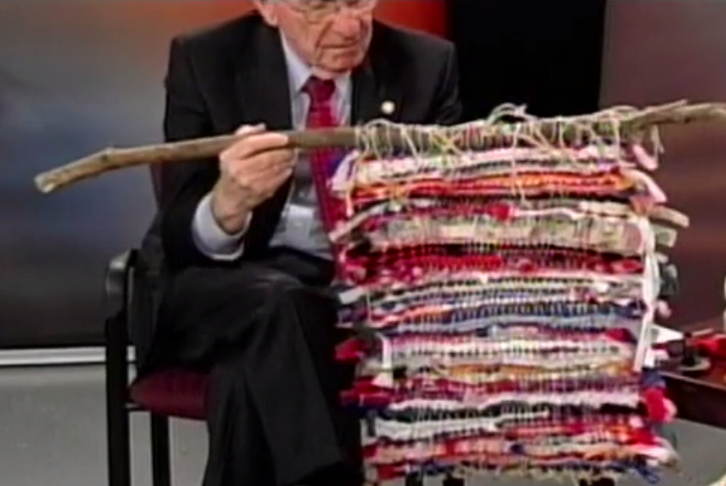
Carla: This year’s Maker Faire, I brought what we made here. I brought my loom which is a big large eight foot tall loom. We had some thread on there and we encouraged the kids to weave bits of trash. So there’s lot of different things in there. There is some fabric, old socks that had holes in them that we cut into loops, bits of plastic bags, whatever we had around, people were weaving it.
Delegate Plum: I can see something with printing on it.
Carla: One thing I have quite a bit – interior designers, when they change their stock, they have all these samples. So I have a couple of them donate to me their old stock. I’ll get these fabric samples and the fabric part is very usable to make into bags, but you know there is that slip of paper on there that will say what the upholstery fabric is. That’s harder to use.
Delegate Plum: That’s what I’m reading on the back here.
Carla: That’s what you are reading on the back there.
Delegate Plum: And so you had kids participating in that with the idea they could go home and they could make a mug mat.
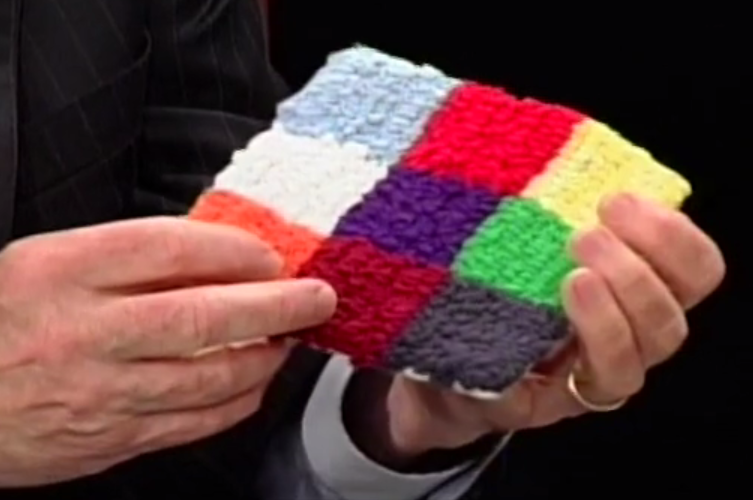
Carla: Sure, they could. This is another way of doing it. I’ll pass that to you. This is by rug hooking. Now I’m originally from Nova Scotia and in Nova Scotia, we do a lot of rug hooking which is using a kind of a hook to pull little loops of fabric up through burlap. If you look at the back there, that’s a rice bag – an old rice bag.
Delegate Plum: So this is, itself, a piece of trash.
Carla: And then the colorful fabric is strips of t-shirts. This is just a tiny one to show as a sample but you can make a whole rug out of it.
Delegate Plum: Well as a man with about 100 t-shirts, I could probably make a lot of these. I could make a whole rug.
Carla: T-shirts are very plentiful and it’s a nice fabric to use in a lot of projects.
Delegate Plum: But you go on and on with other things. Now this one, I recognize the components of it, but let’s describe how you made this toy.
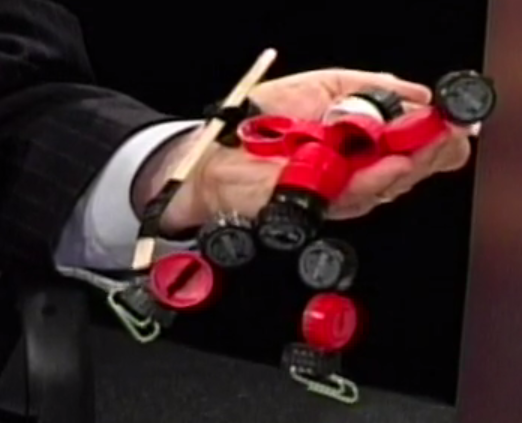
Carla: My daughter is a hockey player and she was having a birthday party and we wanted to have a hockey-themed birthday party. So I designed this little person, little hockey player out of plastic caps and a popsicle stick hockey stick. One of the things I like to do with my designs, I’m not a big fan of glue. I think glue breaks. So you’ll notice in pretty much everything I do, I avoid glue if I can. So the way we did this, rather than gluing the caps together, I used a power drill to drill holes in it. Then we used pipe cleaners and then the girls could make the joints of the person and it would bendy. And also get them to think about how the body hangs together, in a way, right?
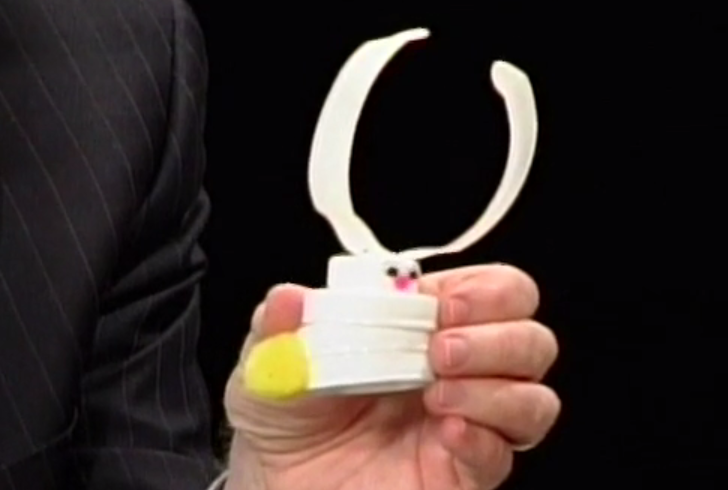
Delegate Plum: So we go along and we have this little bunny.
Carla: My children are a little older now, but when they were smaller, I was always trying to design crafts that a three-, four-, five-year old could do. One of the fine motor control design things that I would do, to weave some fabric up through some holes in these plastic caps. This bunny is not glued. His eyes are glued, but he’s got a spine up through the middle of him made out of string. Teaching kids how it would go up and come back down. The ears of the bunny are made out of a shampoo bottle – that type two plastic that is kind of easy to cut. I also love milk jug plastic because you can use kitchen scissors to cut them into any shape. So if your kids are into horses or kitty cats or whatever, you cut those shapes and then they can draw right on the plastic and make things they can hang in the window.
Delegate Plum: Here you have – this looks like a very elaborate.
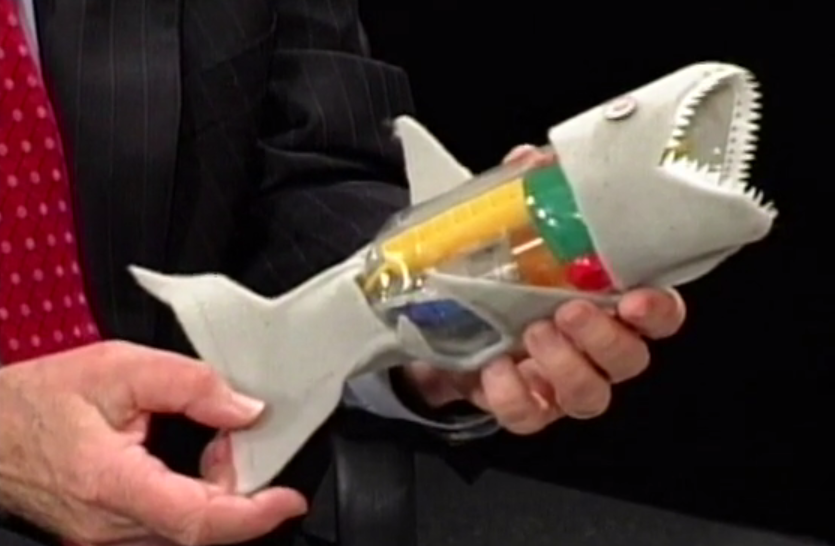
Carla: This is a project I’m still working on. My idea is that I would like to teach kids about anatomy. I call it Trash Anatomy. The idea is that I would like to use soda bottles to be the body of the animal and then use trash to be the organs of the animal. I started with a shark because shark anatomy is really interesting. I don’t know if you know this but the intestine of a shark is a spiral instead of a long tube.
Delegate Plum: I had no idea.
Carla: It’s really cool actually. You know when you have a soap pumper and it has a spiral inside. It looks just like a shark intestine. That’s what gave me the idea originally.
Delegate Plum: Now I remember this specifically from the show.
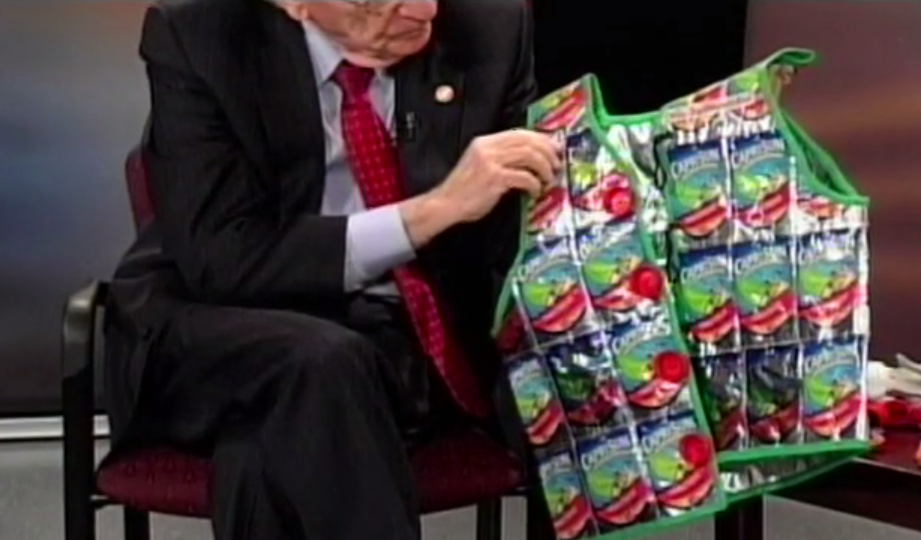
Carla: I was wearing this. I’ve made a few vests out of these juice pouches and then making the buttons out of the soda bottle or whatever kind of plastic caps. People love wearing these. I’ve made now quite a few because when they come to my table at the Maker Faire, they love to put them on and get their picture taken. But actually people ask me a lot of questions about juice pouches. They say, do I need a special sewing machine, or special needle or special thread? No – it sews like fabric. I do use a denim needle, which is a slightly stronger needle. But it’s normal thread. People ask me, how do I clean them? So for example, you take the juice pouches and at the bottom there is a little foldy part. You take an exacto knife, make a little slice, put your bottle brush in there and it cleans right out.
Delegate Plum: For folks who don’t know about the Capri Sun, that is typically a children’s drink. It’s a pouch about this size and you stick a straw in the top. When you have young children, you accumulate a lot of these pouches.
Carla: Especially at birthday parties and soccer games. Often different families are assigned to bring a snack. So you can get 20 at one soccer game.
Delegate Plum: As you point out, this is stitched together just like it was a quilt. You are just quilting together the Capri Suns.
Carla: And if you wanted, you could put the shiny side out – I’ve seen people make those things they put in the windshield of the car to keep the car from over-heating. They use this same thing to make that. You just put the silver side out and it reflects the sun.
Delegate Plum: And it’s easy to clean – it just wipes off. And finally, we realize that you have made a hat as well. I’m not sure what this is made from. What is a lemonade hat?
Carla: You can get little crystals of powder to make lemonade and they are little tubes. I sewed a bunch of them together then used a pattern to make a hat. I thought it would be nice to wear on a rainy day because it keeps your head dry and it’s sunny-looking. My daughter loves hats and looks really beautiful in hats so I made this for her.
Delegate Plum: Now what we need to have people understand is that when you look at this you say, well, I see that’s a bunch of bottle caps or whatever. But it’s really a little more complicated than that when you go from a concept to a product. And you have a system for how you do that. Talk a little bit about that – is it Innovation Engineering?
Carla: That’s right. This is my hobby, right, this is what I do for enjoyment. My business is that I consult with companies to help them develop new business lines, often things that they can patent. The methodology we use for that is called Innovation Engineering. This is a growing movement to help people. The number of Americans who are creating patents is going down as compared to people from other countries. So we really need to get our children thinking about inventing things that are meaningful and unique in this world so that we can be competitive but also so that our businesses can be competitive. This methodology has a bunch of tools that we use and we go into a company and let’s say it’s a company that has been around for a while, and they had a great idea, and they were doing really well, but now maybe their idea is fading a little bit – we can help them rejuvenate their company using this methodology. And I use the same methodology when I’m coming up with ways to use plastic bags or plastic caps or whatever trash item I have.
Delegate Plum: Is the process going from a need that you are trying to meet or is it going from a resource that you are trying to utilize, or a bit of both?
Carla: It’s a bit of both. It depends. Usually the way I want to start is with an idea of a need – a customer who has a need, especially when I’m working with a business. With Trashmagination, it tends to start with whatever I can collect in quantity. But for example when I saw that soap pump, that little swirl. I thought that looks like a shark intestine. Of coruse then I went back and I started surveying teachers asking do you teach anatomy? Would this be a useful product for you in your classroom? So you can start from either direction.
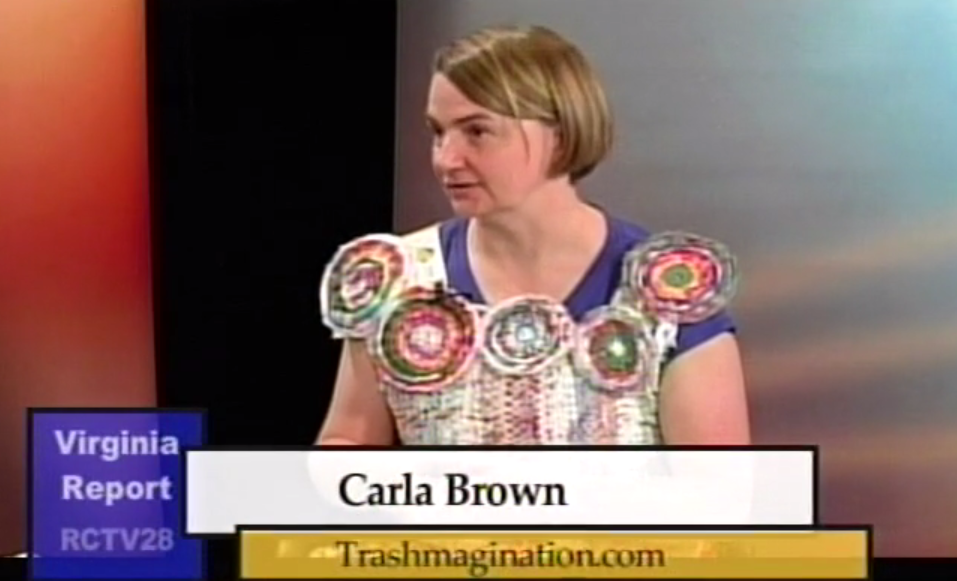
Delegate Plum: The interest that you get from – for example appearing at the Maker Faire – do you go to other events and so on to talk about what you are doing?
Carla: The Maker Faire is the only event I go to and that’s because I just believe so strongly in the Maker movement and Nova Labs. I think it’s just a tremendous force in our community. It’s going to transform Reston and make our kids much more competitive and interesting people. Events are not my main focus. My main focus is designing the activities, putting them up on my blog so that people can replicate them at home. I just love talking with other makers as well. I’ve got quite a network now of people across the whole world who are making things out of trash. We share ideas with each other. We call it creative reuse instead of just recycling.
Delegate Plum: I like that!
Carla: Yeah! There are also stores that focus on gathering materials and teaching people how to do creative reuse. There is one in Alexandria called Upcycle Recycle. There is this whole movement of people who are trying to think creatively about trash.
Delegate Plum: So if we go to your website, we can get connected then to your network and we can see not only the kinds of things you are doing but also the kinds of things other people are doing.
Carla: I have this page called “My World Tour” and that’s if I had unlimited funds, I would love to just go all over the world and meet these people in person. But with the internet, you can have great conversations and really understand what others are developing. Like this idea of this circle for this dress came from a woman who was doing it with t-shirt strips. She had cut her t-shirts into strips and was making rugs like this. So I saw her rug and I thought, well, I don’t want to use t-shirts but I’ll borrow her method to make my circles.
Delegate Plum: Now talk a little bit more about you see this impacting children. You talked about the Maker movement and Nova Labs and the impact it has on the community. Talk a little more about how you see that impacting on children.
Carla: There are different learning styles – visual, audio, kinesthetic. I think our school system spends a lot of time on visual and audio, and less on kinesthetic. What I mean is using our hands to learn. I’m a kinesthetic learner, I love to learn by manipulating things. And my children definitely love – respond to moving things with their hands. I don’t have any aspirations of changing our school system, but if I can inspire a teacher to incorporate a few activities into their classroom that involve the kids moving their bodies, touching things, building things, then I will be thrilled.
Delegate Plum: My own personal experience growing up in a rural area with not a lot of money, I would often see activities that I would then try to replicate with whatever I could by way of resources. It turned out that in our rural part of Virginia, a major gas transmission line came through there. It was always fascinating to go and watch these big digger machines dig out the trenches. They welded together these huge long pipe. That became part of a transmission system for natural gas. When I went home to try to think about how it is that I could engineer something like that to do something like this, as a I guess about a ten-year-old at that time, the idea came to me that all the cans we had in our house were actually pipe, and when mom would cut off the lid to use the can, if I could cut off the bottom, then it was a pipe. While I didn’t have welding capability, I did have an old bicycle inner tube, which when I cut it wide, it made a big wide inner tube and it would connect all those cans. Suddenly I had a transmission system! I went out by the creek bank, I could just dig myself out a trench. Then I could put my pipeline into place. What I liked about that, and what I sometimes am concerned about is that children now, who have access to so many things to provide them with safe toys, they don’t have the opportunity to have the fun and thrill to come with things themselves. So the ways in which you and others can – and certainly there are wonderful creative teachers doing this as well – encourage kids to get their hands in the dirt, to handle materials and products. And you learn something about the quality of various materials and so on. I commend you for your work encouraging teachers to do that.
Carla: Thank you. I think that is a type of knowledge. You figured out that the can would behave in a certain way and the rubber of the tire would behave – that’s material science. Sometimes when I’m working with kids and they can barely use their scissors. They don’t know that they can cut something. That tells me that they haven’t been manipulating those materials very much. They don’t think that way. To me, I want them to have that knowledge because that’s how things get invented, right? That you have this instinctive understanding of how materials behave, makes you think about using them in a different way. That’s how things get solved in the world, right? When people have an instinctive knowledge that they apply to solve a problem.
Delegate Plum: Back to your early experience on the island with the reduced use of containers, I see a little bit of that happening now in some of the stores and so on.
Carla: Like canvas bag certainly. People are better about taking their bags. When I was trying to make this dress, I had no bags. I had mostly white or beige. So I had to really network to get colorful bags. To me that’s a good sign, that it took a lot of effort. I mean there are hundreds of bags in this dress. That it took a lot of effort to get the bags is actually – Yeah! Other things, like I think about water bottles, disposable drinks, I wish people would be more likely to take their water bottles to event rather than buying a drink. I think some people are very conscientious about it, and some people, it just doesn’t register.
Delegate Plum: Some folks don’t realize that the water off the tap in Fairfax County is as good as the water in the bottle that you buy in the store. They meet the same standards and so on.
Carla: It tastes great!
Delegate Plum: It tastes great and it is great. The fact of the matter is that if you have one last water bottle that you bought, drink it, and then fill it at the tap at home and take it with you. That can be your last water bottle, and you don’t need to buy a water bottle because you have a bottle.
Carla: Like at my daughter’s hockey rink, they have a counter on their water fountain. It says how many thousands of water bottles have been filled at that device. It’s this enormous number. That’s just one hockey rink and one water fountain. If you think about if all those people bought their drinks instead, an enormous amount of plastic.
Delegate Plum: People again have this notion that it’s somehow better because it’s in a bottle. It’s just not so. Where are you going to go with this?
Carla: It’s a good question. For me this is my relaxation, right? This is what I do to take it easy at the end of the day. Maybe some day it will become a business of some sort. I certainly admire the people who run these creative reuse stores. I think they are doing something really wonderful. Right now, though, I’m really enjoying consulting with businesses and helping them be more competitive and bring their inventions to market.
Delegate Plum: If you go to a creative reuse store, what happens there?
Carla: It’s really neat. Most of them – I have been to quite a few – most of them the way it works is that you get a bag – let’s say like a brown bag like you might get at a Starbucks or whatever, you can put anything in the bag for $10. So you just walk around the store and whatever you see that you can cram into the bag, you get it. But then some of the things that are more expensive objects, they put a price on them. But it’s amazing how much you can get into the bag.
Delegate Plum: These are leftover materials from manufacturing processes and so on.
Carla: Often. But also donated from crafters and artists. They may say, I don’t really need all these beads anymore, I’m going to donate them. For example, if you are a person who likes to do crafts, and you tend head over to a craft supply store, I would encourage you to first go to the Upcycle Recycle. Because first of all, it’s a lot cheaper, but also you are reducing the amount of stuff that is getting purchased.
Delegate Plum: On the larger scale, you’ve got ReStore with Habitat doing it with larger items.
Carla: Tremendous store there. They do a great job getting people to use what’s left rather than buying all new.
Delegate Plum: Well, Carla Brown, we appreciate you being on the show. And folks who want to join you on your journey can hook up on your website.
Carla: That’s right, or like it on Facebook as well. I put all the posts on Facebook if you are a fan of that.
Delegate Plum: And on Facebook, it’s what?
Carla: It’s Trashmagination – same – so facebook.com/trashmagination.
Delegate Plum: Thank you for being on the show and I look forward to seeing you at the next Maker Faire.
Carla: I look forward to being there too.
Delegate Plum: Ladies and gentleman, I’m glad you were with us tonight and hope you join us next week at the same time. In the meantime, recycle the products you have at home. If you can’t turn them into something where you reuse them, at least recycle them. Be concerned when your trash bag is too full, something is not right. This is Ken Plum, I want to thank you for being with us. Hope you join us next week at the same time. Good night!
